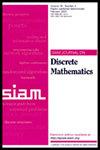Left-Cut-Percolation and Induced-Sidorenko Bigraphs
IF 0.9
3区 数学
Q2 MATHEMATICS
引用次数: 0
Abstract
SIAM Journal on Discrete Mathematics, Volume 38, Issue 2, Page 1586-1629, June 2024.Abstract. A Sidorenko bigraph is one whose density in a bigraphon [math] is minimized precisely when [math] is constant. Several techniques in the literature to prove the Sidorenko property consist of decomposing (typically in a tree decomposition) the bigraph into smaller building blocks with stronger properties. One prominent such technique is that of [math]-decompositions of Conlon and Lee, which uses weakly Hölder (or weakly norming) bigraphs as building blocks. In turn, to obtain weakly Hölder bigraphs, it is typical to use the chain of implications reflection bigraph [math] cut-percolating bigraph [math] weakly Hölder bigraph. In an earlier result by the author with Razborov, we provided a generalization of [math]-decompositions, called reflective tree decompositions, that uses much weaker building blocks, called induced-Sidorenko bigraphs, to also obtain Sidorenko bigraphs. In this paper, we show that “left-sided” versions of the concepts of reflection bigraph and cut-percolating bigraph yield a similar chain of implications: left-reflection bigraph [math] left-cut-percolating bigraph [math] induced-Sidorenko bigraph. We also show that under mild hypotheses the “left-sided” analogue of the weakly Hölder property (which is also obtained via a similar chain of implications) can be used to improve bounds on another result of Conlon and Lee that roughly says that bigraphs with enough vertices on the right side of each realized degree have the Sidorenko property.
左切-珀切和诱导-西多伦科大图
SIAM 离散数学杂志》第 38 卷第 2 期第 1586-1629 页,2024 年 6 月。 摘要。Sidorenko bigraph 是指当[math]为常数时,其在 bigraphon [math] 中的密度最小。文献中证明 Sidorenko 性质的几种技术包括将 bigraph 分解(通常是树形分解)为具有更强性质的较小构件。康伦和李的[math]分解是其中一种突出的技术,它使用弱荷尔德(或弱规范)大图作为构建块。反过来,要得到弱荷尔德 bigraphs,典型的方法是使用蕴涵链反射 bigraph [math] cut-percolating bigraph [math] 弱荷尔德 bigraph。在作者与拉兹伯洛夫(Razborov)的早期成果中,我们提供了[数学]分解的广义化,称为反射树分解,它使用弱得多的构件,称为诱导-西多伦科大图,同样可以得到西多伦科大图。在本文中,我们证明了 "左侧 "版本的反射 bigraph 和切割-珀尔帖 bigraph 概念会产生类似的蕴涵链:左侧反射 bigraph [math] 左侧切割-珀尔帖 bigraph [math] 诱导-西多连科 bigraph。我们还证明,在温和的假设条件下,弱荷尔德性质的 "左侧 "类似物(也是通过类似的蕴涵链得到的)可以用来改进康伦和李的另一个结果的边界,该结果大致是说,在每个实现度的右侧有足够顶点的 bigraph 具有 Sidorenko 性质。
本文章由计算机程序翻译,如有差异,请以英文原文为准。
求助全文
约1分钟内获得全文
求助全文
来源期刊
CiteScore
1.90
自引率
0.00%
发文量
124
审稿时长
4-8 weeks
期刊介绍:
SIAM Journal on Discrete Mathematics (SIDMA) publishes research papers of exceptional quality in pure and applied discrete mathematics, broadly interpreted. The journal''s focus is primarily theoretical rather than empirical, but the editors welcome papers that evolve from or have potential application to real-world problems. Submissions must be clearly written and make a significant contribution.
Topics include but are not limited to:
properties of and extremal problems for discrete structures
combinatorial optimization, including approximation algorithms
algebraic and enumerative combinatorics
coding and information theory
additive, analytic combinatorics and number theory
combinatorial matrix theory and spectral graph theory
design and analysis of algorithms for discrete structures
discrete problems in computational complexity
discrete and computational geometry
discrete methods in computational biology, and bioinformatics
probabilistic methods and randomized algorithms.

 求助内容:
求助内容: 应助结果提醒方式:
应助结果提醒方式:


